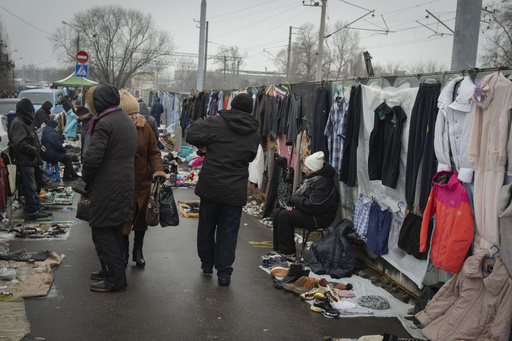
People sell objects at a city flea market in Ukraine’s capital Kyiv, Sunday, Feb. 11, 2024. Despite more and more buyers having to tighten their belts, the market still offers a large variety of goods as it survived the second year of war with Russia. AP
KYIV, Ukraine — Russian forces launched 45 drones over Ukraine in a five-and-a-half-hour barrage Sunday, officials said, as Ukrainian President Volodymyr Zelensky continued the reshuffle of his war cabinet as the war enters its third year.
In a statement, the Ukrainian air force said it had shot down 40 of the Iranian-made Shahed drones over nine different regions, including on the outskirts of the country’s capital, Kyiv.
The attack targeted agricultural facilities and coastal infrastructure, officials for Ukraine’s southern defense forces wrote on Telegram. They said that a strike in the Mykolaiv region had injured one person, sparking a fire and damaging residential buildings.
READ: Zelensky appoints new ground forces chief
Another person was injured in Ukraine’s Dnipropetrovsk region when a blaze broke out due to falling debris from a destroyed drone, said the head of the region’s military administration, Serhiy Lysak.
Border police in Moldova also said Sunday that fragments of a “Shahed-type drone” were found near the southern town of Etulia close to the border with Ukraine, but that the debris posed no danger to communities nearby.
“There is a suspicion that the detected drone debris is one of the drones shot down by the Ukrainian anti-aircraft system,” the border police said in a statement, referencing overnight attacks launched on Friday by Russian forces on Ukraine’s Izmail region.
The distance between Etulia and Izmail is about 40 kilometers (25 miles) as the crow flies. Authorities said access to the impact site has been restricted.
Moldovan President Maia Sandu posted on the social media platform X, that “Russia’s war on Ukraine hits close to home in Moldova — again.”
“The discovery of Shahed drone debris in southern Moldova today serves as another stark reminder of the grim reality we face,” she said. “Russia’s aggression endangers the entire continent. Support for Ukraine must continue.”
The strikes come as Zelensky continues his shakeup of military commanders in a bid to maintain momentum against attacking Russian forces.
Kyiv announced Sunday that former deputy defense minister Lt. Gen. Alexander Pavlyuk would become the new commander of Ukraine’s ground forces. The post was previously held by Col. Gen. Oleksandr Syrskyi, who was named Thursday as the replacement for Ukraine’s outgoing military chief, Gen. Valerii Zaluzhnyi.
READ: Ukrainian family of five die in Russian drone attack in Kharkiv
New presidential decrees also named Yurii Sodol, the former head of Ukraine’s marine corps, as the new commander of Ukraine’s combined forces; Brig. Gen. Ihor Skibiuk as commander of Ukraine’s air assault forces; and Maj. Gen. Ihor Plahuta as commander of Ukraine’s territorial defense forces.
Incoming commander-in-chief Syrskyi has signaled that his immediate goals include improving troop rotation at the front lines and harnessing the power of new technology at a time when Kyiv’s forces are largely on the defensive.
Starlink concerns
Ukraine’s military intelligence service said Sunday that attacking Russian forces had been found using Starlink terminals to aid their attack. It released what it said was a recording of an intercepted conversation between two Russian soldiers as proof.
Starlink terminals, which use a series of satellites run by Elon Musk’s company Space X to provide high-speed communications, have been vital in giving Ukraine’s military an edge over invading Russian troops.
However, multiple reports of Russian troops using Starlink on the front line in occupied Ukraine had begun to surface in the Ukrainian media in recent weeks.
They prompted Space X to release a statement on social media on Feb. 8, saying that it did not “do business of any kind with the Russian government or its military.”
However, Western tech components have regularly been found among Russia’s arsenal as Moscow has become more skilled at evading sanctions, often importing goods via third countries.
In a statement on Telegram on Saturday, Zelensky said that he hoped to “reboot” the upper levels of Ukraine’s armed forces with experienced combat commanders.
“Now, people who are well-known in the army and who themselves know well what the army needs are taking on new responsibilities,” he said.